 W
WAdalia bipunctata, the two-spot ladybird, two-spotted ladybug or two-spotted lady beetle, is a carnivorous beetle of the family Coccinellidae that is found throughout the holarctic region. It is very common in western and central Europe. It is also native to North America but it has heavily declined in many states and provinces. It is commonly introduced and imported as a biological control agent.
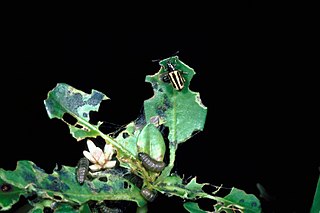 W
WAgasicles hygrophila is a species of leaf beetle known by the common name alligator weed flea beetle. It has been used successfully as an agent of biological pest control against the noxious aquatic plant known as alligator weed.
 W
WAgrilus hyperici, the St. John's wort root borer, is a species of jewel beetle. It is used as an agent of biological pest control against common St. John's wort in areas where it is a noxious weed or invasive species.
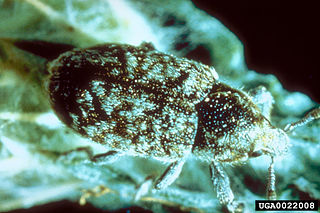 W
WBangasternus fausti is a species of true weevil known as the broad-nosed seed head weevil. It is used as an agent of biological pest control against noxious knapweeds, particularly spotted knapweed, squarrose knapweed, and diffuse knapweed.
 W
WA beetle bank, in agriculture and horticulture, is a form of biological pest control. It is a strip planted with grasses and/or perennial plants, within a crop field or a garden, that fosters and provides habitat for beneficial insects, birds, and other fauna that prey on pests.
 W
WBruchidius villosus is a species of bean weevil known by the common names broom seed beetle and Scotch broom bruchid. This beetle is used as an agent of biological pest control against the noxious weed known as Scotch broom.
 W
WChilocorus stigma, commonly known as the twice-stabbed ladybug, is a native resident of the United States and Canada but does not live west of the Sierra Nevada.. It also has been introduced to Hawaii. It is shiny black, and there is one red spot on each elytron. The remainder of the body is black as well, but the abdomen is either yellow or red. It is sometimes confused with the "two-stabbed lady beetle", Chilocorus orbus, which is widespread in California.
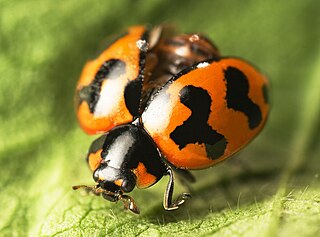 W
WCoccinella is the most familiar genus of ladybird. The elytra of most species are of a red or orange colour, punctuated with black spots or bands. The genus occurs throughout the Northern Hemisphere, but has only 11 species native to North America, with far more in Eurasia.
 W
WCoccinella septempunctata, the seven-spot ladybird, is the most common ladybird in Europe. Its elytra are of a red colour, but punctuated with three black spots each, with one further spot being spread over the junction of the two, making a total of seven spots, from which the species derives both its common and scientific names.
 W
WCoccinellidae is a widespread family of small beetles ranging in size from 0.8 to 18 mm. The family is commonly known as ladybugs in North America and ladybirds in Britain and other parts of the English-speaking world. Entomologists prefer the names ladybird beetles or lady beetles as these insects are not classified as true bugs.
 W
WColeomegilla maculata, commonly known as the spotted lady beetle, pink spotted lady beetle or twelve-spotted lady beetle, is a large coccinellid beetle native to North America. The adults and larvae feed primarily on aphids and the species has been used as a biological control agent. Based on name connotation and to avoid confusion with other species also called "spotted ladybeetle", spotted pink ladybeetle is probably the most appropriate common name for this species.
 W
WCyphocleonus achates is a species of true weevil known as the knapweed root weevil. It is native to southern Europe and the Mediterranean and is used as an agent of biological pest control against noxious knapweeds, especially spotted knapweed. It has recently been spotted in India.
 W
WCyrtobagous salviniae is a species of weevil known as the salvinia weevil. It is used as an agent of biological pest control against the noxious aquatic plant giant salvinia.
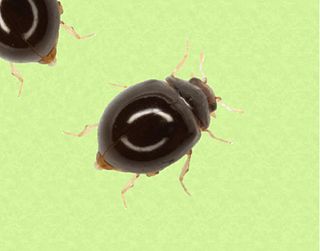 W
WDelphastus pusillus is a small ladybird beetle which preys on all species and stages of whitefly, but prefers eggs and nymphs. The adults are small, shiny, black beetles. Newly emerged adults are pale-brown to almost white. They eventually turn black with a brown head. The eggs are 0.2 mm long, clear and twice as long as they are wide. The elongate larvae are pale yellow.
 W
WDiorhabda carinata is a species of leaf beetle known as the larger tamarisk beetle which feeds on tamarisk trees from Ukraine, eastern Turkey and Syria east to northwest China, Kyrgyzstan and Pakistan, extending as far south as southern Iran. It is used in North America as a biological pest control agent against saltcedar or tamarisk, an invasive species in arid and semi-arid ecosystems.
 W
WDiorhabda carinulata is a species of leaf beetle known as the northern tamarisk beetle, which feeds on tamarisk trees from southern Russia and Iran to Mongolia and western China. This beetle is used in North America as a biological pest control agent against saltcedar or tamarisk, an invasive species in arid and semiarid ecosystems.
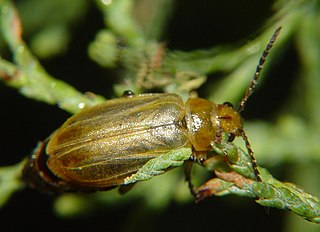 W
WDiorhabda elongata is a species of leaf beetle known as the Mediterranean tamarisk beetle (MTB) which feeds on tamarisk trees from Portugal and Algeria east to southern Russia. The MTB is used in North America as a biological pest control agent against saltcedar or tamarisk, an invasive species in arid and semi-arid ecosystems.
 W
WDiorhabda meridionalis is a species of leaf beetle known as the southern tamarisk beetle (SoTB) which feeds on tamarisk trees from Syria to western and southern Iran and southern Pakistan. The SoTB may have potential for use in North America as a biological pest control agent against saltcedar or tamarisk, an invasive species in arid and semi-arid ecosystems.
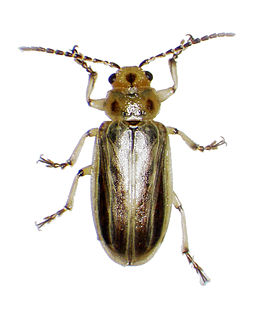 W
WDiorhabda sublineata is a leaf beetle known as the subtropical tamarisk beetle (STB). The species was first described by Hippolyte Lucas in 1849. It feeds on tamarisk trees from Portugal, Spain and France to Morocco, Senegal, Algeria, Tunisia, Egypt, Yemen, and Iraq. It is used in North America as a biological pest control agent against saltcedar or tamarisk, an invasive species in arid and semi-arid ecosystems.
 W
WEustenopus villosus is a species of true weevil known as the yellow starthistle hairy weevil. It is used as an agent of biological pest control against the noxious weed yellow starthistle.
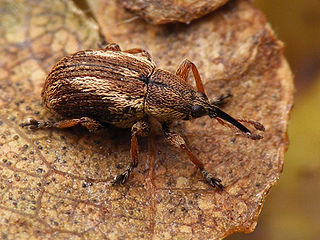 W
WExapion fuscirostre is a species of straight-snouted weevil known by the general common name Scotch broom seed weevil. It is used as an agent of biological pest control against the noxious weed known as Scotch broom.
 W
WExapion ulicis is a species of straight-snouted weevil known by the general common name Gorse Seed Weevil. It is used as an agent of biological pest control against Common Gorse, which is classified as a noxious weed in some countries.
 W
WGalerucella calmariensis is a species of leaf beetle in the family Chrysomelidae. It is commonly known as the black-margined loosestrife beetle and is native to Europe and Asia where both adults and larvae feed on purple loosestrife. It has been introduced in North America as a biological control agent for purple loosestrife.
 W
WGratiana boliviana is a species of beetle in the leaf beetle family, Chrysomelidae. Its common name is tropical soda apple leaf beetle. It is native to South America, where its distribution includes Argentina, Brazil, and Paraguay. It specializes on tropical soda apple, an invasive plant species. It has been released as an agent of biological pest control against the weedy plant in Florida and other parts of the United States.
 W
WHarmonia axyridis, most commonly known as the harlequin, multicolored Asian, or Asian ladybeetle, is a large coccinellid beetle. This is one of the most variable species in the world, with an exceptionally wide range of color forms. It is native to eastern Asia, but has been artificially introduced to North America and Europe to control aphids and scale insects. It is now common, well known, and spreading in those regions, and has also established in Africa and widely across South America. This species is conspicuous in North America, where it may locally be known as the Halloween ladybeetle. It earns this name as it often invades homes during October to overwinter.
Hippodamia convergens, commonly known as the convergent lady beetle, is one of the most common lady beetles in North America and is found throughout the continent. Aphids form their main diet and they are used for the biological control of these pests.
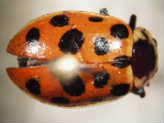 W
WHippodamia tredecimpunctata, commonly known as the thirteen-spot ladybeetle, is a species of lady beetle.
 W
WHylobius transversovittatus is a species of weevil in the family Curculionidae. It is native to the Old World where both adults and larvae feed on purple loosestrife. This plant is regarded as an invasive species in North America and the weevil has been introduced into both the United States and Canada in an effort to control the plant.
 W
WLarinus curtus is a species of true weevil known as the yellow starthistle flower weevil. It is native to Southern Italy, Southern Europe, the Middle East and the Caucasuses. It is used as an agent of biological pest control against the noxious weed yellow starthistle in the United States.
 W
WLarinus latus is a species of true weevil. It is used as an agent of biological pest control against Onopordum thistles in Australia.
 W
WLarinus obtusus is a species of true weevil known as the blunt knapweed flower weevil. It is used as an agent of biological pest control against noxious knapweeds, especially spotted knapweed.
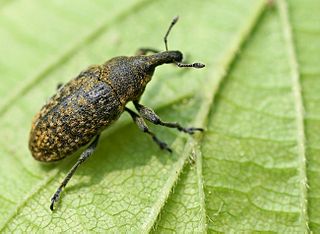 W
WLarinus planus is an insect of the Curculionidae family. They are oval shaped, dark brown or black, and about 5–10 millimetres long. While native to Europe, it is also common in North America. It feeds on floral buds, primarily of thistles, with the larvae stage being the most destructive to them. In North America, it has been used as a biocontrol agent. It is also known as Larinus carlinae.
 W
WLebia grandis is a ground beetle in the family Carabidae found in North America. It is a specialist predator on the eggs and larvae of Colorado potato beetles, and its larvae are obligate parasitoids of Colorado potato beetle pupae.
 W
WLochmaea suturalis, commonly referred to as the heather beetle, is a beetle of the genus Lochmaea native to north-west Europe. It feeds upon heather. They are difficult to spot as they are camouflaged with a brownish colour, and are about 6 millimetres (0.24 in) long. They have a tendency to hide, and they drop into the undergrowth if they are disturbed. They are easier to see when in large numbers on the same plant.
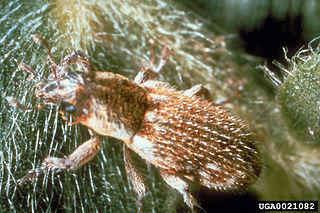 W
WMicrolarinus lareynii is a weevil of the family Curculionidae. It is native to interior regions of Italy, France and Rajasthan in India.
 W
WParevander xanthomelas is a species of beetle in the family Cerambycidae. It was described by Félix Édouard Guérin-Méneville in 1844, and has been classified in the genus Parevander since the circumscription of that genus by Per Olof Christopher Aurivillius in 1912.
 W
WRhinocyllus conicus is a species of true weevil. It is best known as a controversial agent of biological pest control which has been used against noxious thistles in the genera Carduus, Cirsium, Onopordum, and Silybum.
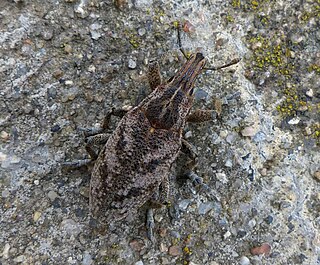 W
WThe sluggish weevil or large thistle weevil, Cleonis pigra, is a weevil species recorded in Britain and native to Eurasia. It was introduced into North America to help control creeping thistle. This species develops in the roots of plants on the family Asteraceae.
 W
WThe soldier beetles (Cantharidae) are relatively soft-bodied, straight-sided beetles. They are cosmopolitan in distribution. One of the first described species has a color pattern reminiscent of the red coats of early British soldiers, hence the common name. They are also known commonly as leatherwings because of their soft elytra.
 W
WLongitarsus jacobaeae is a species of flea beetle known as the tansy ragwort flea beetle. It is used as an agent of biological pest control against the nectar-rich noxious weed known as ragwort.
 W
WThe thistle tortoise beetle is a species of leaf beetle, situated in the subfamily Cassidinae and the genus Cassida.
 W
WTrichosirocalus horridus is a species of true weevils, native to Europe. It is a biological pest control agent that was introduced into the United States in 1974 to control exotic thistles, especially in the Cirsium and Carduus genera.
 W
WZygogramma bicolorata, variously referred to as the Parthenium beetle or Mexican beetle, is a species of leaf beetle in the subfamily Chrysomelinae, native to Mexico.
 W
WZygogramma suturalis, commonly known as the ragweed leaf beetle, is a species of leaf beetle belonging to the genus Zygogramma. Native to North America, it has been introduced into Russia and China for the biological pest control of ragweed.